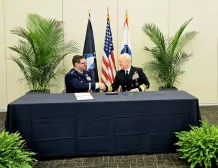Acquisition chief sees autonomous satellites as wave of the future for Space Force

Cutting back on ground stations and operators, embracing autonomous satellites and experimenting with “strange” orbits, could be the wave of the future for the Space Force, a top acquisition official suggested.
Service leaders have warned about the risks to the ground segments of U.S. military space architectures from cyber threats or other adversary methods, seeing them as a potential “backdoor” way of attacking American satellite communications.
Additionally, delays in delivering ground systems from industry can set back space programs.
“I’ve always been an advocate that probably our biggest threats are ground. And I would love to see a future — and I’m thinking way out there — that more satellites are autonomous. I really see a future where there are autonomous satellites with onboard processing. I mean, you think about what’s in your iPhone today, I mean, there’s no reason why we can’t be doing much more stuff onboard processing, and just downlink and tasking to whoever we need it to,” Frank Calvelli, assistant secretary of the Air Force for space acquisition and integration, said Friday at an event hosted by the Center for Strategic and International Studies.
“So, I envision a day down the road, maybe 20 years, where there’s a lot less ground stations and a lot less operators. Right? And then if you think about where all these commercial companies are going with direct-to-phone kind of service from space, you can almost envision you don’t need ground terminals anymore, you can go directly to a commercial provider or commercial providers, right in terms of these … systems. So, I see a future that’s very autonomous and very much more onboard processing — and I think that makes us much more resilient and survivable than a ground station with lots of people and lots of network connections inside that could be vulnerable to cyber. But that’s just my personal view of the future,” he said.
The Department of Defense is also concerned about adversaries’ anti-satellite weapons that could disrupt the services that space systems provide to military and civilian users. The Pentagon relies on satellites for critical missions such as intelligence, surveillance and reconnaissance (ISR), positioning, navigation and timing (PNT), and communications.
To mitigate these threats, the Space Development Agency is pursuing what it calls a Proliferated Warfighter Space Architecture (PWSA), which includes tranches of data transport and missile-tracking satellites that will operate in low-Earth orbit.
A White House official recently told reporters that Russia is developing a new “anti-satellite capability” that hasn’t been deployed yet. The system could be a space-based weapon with a nuclear component, according to reports. The Kremlin has denied these allegations.
At the CSIS event Friday, Calvelli was asked whether the U.S. is at risk of relying too much on LEO constellations to mitigate risks to American platforms.
He said the Pentagon needs to diversify.
“I think that proliferation in LEO is one approach to resiliency. Other approaches include also that we need to be doing more of is diversification of orbits. And so if you look at the history of the [Defense] Department, most of our stuff was in [geosynchronous orbit], right? Except for GPS, most of our stuff is in GEO — all of our missile warning, all of our MILSATCOM kind of capabilities. And so I’m an advocate of proliferation everywhere. I think we should be proliferating more in [medium-Earth orbit], we should be preferring more in GEO, as well. And so I think we’re taking the first steps through SDA with proliferation in LEO, but I also see us proliferating more at other orbits and trying strange orbits too, as well,” Calvelli said.






